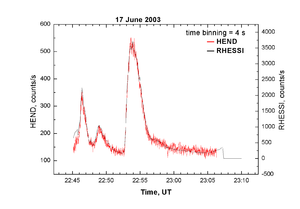Mars Odyssey/HEND and RHESSI
From RHESSI Wiki
(Nugget 202 upload, first part) |
(adding figures) |
||
| Line 28: | Line 28: | ||
The HEND observations of flares on the visible hemisphere basically just supplement the data obtained by other missions on | The HEND observations of flares on the visible hemisphere basically just supplement the data obtained by other missions on | ||
near-Earth orbits, but they may fill in vital gaps in these data. | near-Earth orbits, but they may fill in vital gaps in these data. | ||
| + | Figure 1 shows an example of a flare observed by both HEND and RHESSI. | ||
| - | + | [[File:202f1.png|right|thumb|300px|Figure 1: | |
| - | + | A flare well-observed by both HEND and RHESSI, showing good agreement between RHESSI (65-275 keV in black, and HEND (~80 keV, in red). | |
| - | + | Flare SOL2003-06-17. | |
| - | + | ]] | |
| - | + | ||
| - | of the Sun. | + | We are particularly concerned with HEND data on energetic solar flares for which the RHESSI or other observations happen not to |
| + | be available. | ||
| + | This routinely happens, of course, because roughly half of all flares occur on the invisible hemisphere of the Sun; there is a good chance that a deep-space mission such as Mars Odyssey can have them in sight. | ||
| + | An example of such an event was a flare of 27 October 2002, which was fully on the invisible side of the Sun, and we illustrate this in detail in Figure 2. | ||
| + | |||
| + | [[File:202f2.png|right|thumb|600px|Figure 1: | ||
| + | A flare (SOL2002-10-27) fully on the invisible hemisphere, but perfectly visible to HEND. | ||
| + | ]] | ||
Revision as of 16:02, 2 June 2013
| Nugget | |
|---|---|
| Number: | 200 |
| 1st Author: | V. Vybornov |
| 2nd Author: | M. Livshits |
| Published: | June 10, 2013 |
| Next Nugget: | |
| Previous Nugget: | Hard X-rays in Descent |
| List all | |
Introduction
Mars Odyssey may be little-known to solar physicists, but its HEND (High-Energy Neutron Detector) readily detects solar flares. Generally, flare observations are performed from the Earth or near-Earth orbits. However, there are space missions that operate at various ecliptic longitudes and latitudes in interplanetary space; these can provide different vantage points for solar observations. HEND recorded hard X-ray and gamma-radiation from 40 keV to 2 MeV (Ref. [1]), as a part of the Mars Odyssey mission, and observed solar flares from the middle of 2001 up to 2011. The main working parts of HEND comprise an outer scintillation counter of CsI (energy band from 40 to 1000 keV) plus an inner plastic one, (Stilbene) for the range 300 – 2000 keV. Two types of data are available: the time profiles from the outer and inner scintillators with a resolution of 0.25 s (near 80 keV) and 1 s (near 330 keV) respectively, and spectral data with a resolution of 20 s in 15 energy channels from both scintillators.
In this Nugget we discuss observations of flares visible from the Earth, as a check on the HEND calibrations, and then show observations from the solar hemisphere (the "backside") invisible from Earth.
Simultaneous HEND and RHESSI observations
The HEND observations of flares on the visible hemisphere basically just supplement the data obtained by other missions on near-Earth orbits, but they may fill in vital gaps in these data. Figure 1 shows an example of a flare observed by both HEND and RHESSI.
We are particularly concerned with HEND data on energetic solar flares for which the RHESSI or other observations happen not to be available. This routinely happens, of course, because roughly half of all flares occur on the invisible hemisphere of the Sun; there is a good chance that a deep-space mission such as Mars Odyssey can have them in sight. An example of such an event was a flare of 27 October 2002, which was fully on the invisible side of the Sun, and we illustrate this in detail in Figure 2.
References
[1] Maps of Subsurface Hydrogen from the High Energy Neutron Detector, Mars Odyssey
| RHESSI Nugget Date | 10 June 2013 + |
| RHESSI Nugget First Author | V. Vybornov + |
| RHESSI Nugget Index | 200 + |
| RHESSI Nugget Second Author | M. Livshits + |

